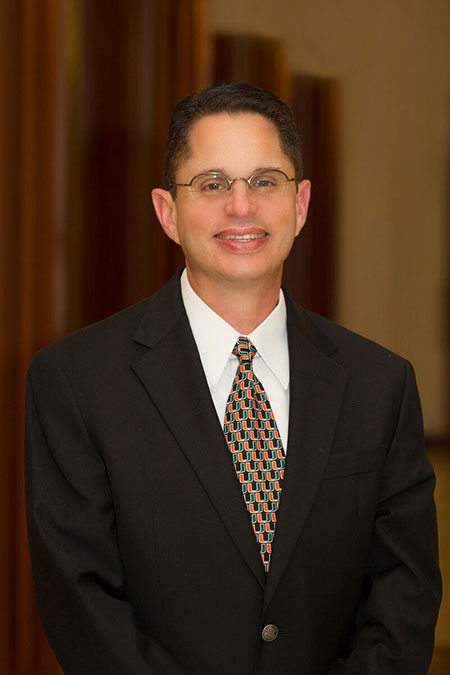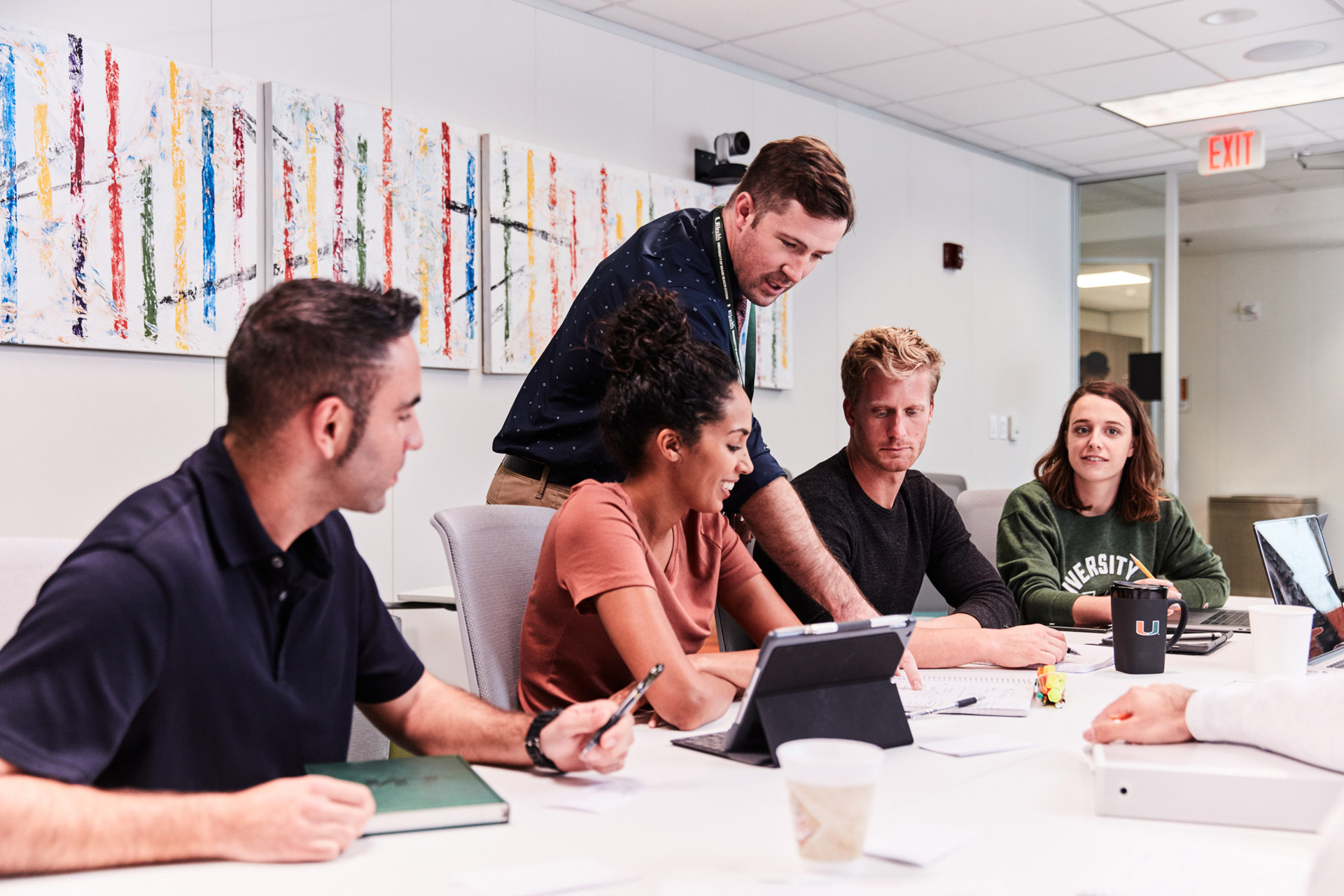Medical Education
Reimagined
The Miller School’s new curriculum is designed to produce physician leaders who will transform patient outcomes
By Christine Morris
Photo illustration by Clint Blowers

A revolutionary new curriculum is being created at the Miller School of Medicine to prepare and inspire future doctors to more effectively treat individual patients — and to begin to transform the entire health care system.
“It’s part of who we are,” said Alex J. Mechaber, M.D., Bernard J. Fogel Chair in Medical Education and senior associate dean for undergraduate medical education. “This school has been predicated on trying to improve health outcomes in our communities — working with the underserved, working with the impoverished, and working with patients who don’t have access to health care. That has been the culture of this institution.”
The curriculum is being reinvented, through the NextGenMD initiative, to build in that commitment to understanding the impact of social determinants of health on patient care, and to instill in students an ability and a responsibility to make the changes that will lead to improved outcomes. “We want our students to be the kind of transformational leaders who are ultimately going to intervene and create solutions to this issue,” Dr. Mechaber said.
As Laurence B. Gardner, M.D., executive dean for education and policy, said, “This curriculum should allow us to produce students who are not only capable of but steeped in self-learning and continuously improving their knowledge and performance. Going further, these physicians should have the skills to assume leadership roles in medicine and related fields, which benefit a larger population than an individual patient.
“And they will begin to help transform the health care system, which is desperately in need of transformation.”
How will the Miller School do this? Nearly 200 faculty, residents and students have spent many months working on eight planning teams to figure that out. In the first phase of the new curriculum, which begins this fall for the Class of 2024, the emphasis will be on case-based learning, rather than the traditional lecture. Clerkships will begin much earlier, too.
“At the end of the day, that’s what medicine is all about,” Dr. Mechaber said. “When you have a patient in front of you who needs care, you have to know what clinical questions to ask, which resources to consider, to be able to determine the next best step for that patient.”
Serving our Global Community
The fundamental inspiration for the curriculum comes from the Miller School’s “why” statement, developed under the leadership of Henri R. Ford, M.D., M.H.A., dean and chief academic officer: “We will empower our students to transform lives and inspire them to serve our global community.”
Dean Ford challenged the planning teams to design a curriculum that is “truly Miller School-specific.” To help advance that process, Dr. Richard M. Schwartzstein, the Ellen and Melvin Gordon Professor of Medicine and Medical Education and chief of the -Division of Pulmonary, Critical Care and Sleep Medicine at Harvard’s Beth Israel Deaconess Medical Center, visited the Miller School earlier this year to show faculty and students how Harvard empowered its students by creating a new curriculum based on patient cases.
“We’re sharing a new model that really emphasizes thinking skills and application of knowledge to solve problems,” said Dr. Schwartzstein, who led the steering committee that established the Pathways curriculum at Harvard in 2015. “This is very different from traditional models of teaching — it puts a lot more emphasis on getting students to work together, it forces them to commit to learn the material in advance, and then they come into the classroom and immediately apply the information to clinical cases.”
Faculty members are designing Miami-specific cases to be used in these sessions. Symptom-based learning will lead students to consider a fuller range of possible explanations for every patient case, and prepare them for their early clinical experiences.
Analyzing these clinical cases, and getting into the hospital or a physician’s office sooner in their training, will make all the difference for students, said Brett Colbert, a second-year M.D./Ph.D. student who has been involved in the ongoing process of redesigning the curriculum — a process led by Amar Deshpande, M.D., professor of medicine and assistant dean for medical education.
“What really prepares you to be a physician is your clinical exposure,” Colbert said. “For every patient I’ve seen, I remember that disease much better than if I’d read it in a book.”
That’s a strong message for interviews with prospective students, he said. “We can tell them we are moving to case-based learning and earlier clerkships, which can propel you into the clinical part of your career. Students seem positive about it.”
“These physicians should have the skills to assume leadership roles in medicine.”
— Laurence B. Gardner, M.D.
Students as Pioneers
The new curriculum is truly a work in progress, Dr. Gardner said. “We’ve told every student we’ve interviewed that they’re going to be partners as we develop this curriculum. Pioneers always seen to do well. Our first M.D./M.P.H. class was spectacular.”
Colbert has devoted so much time and energy to this pioneering work in part because “I have some skin in the game.” He begins work on his Ph.D. next year, and will return to finish his M.D. in three or four years.
When he returns, students in years three and four will be pursuing a more targeted, specialized approach to learning by choosing a pathway if they are not enrolled in one of the school’s distinctive dual-degree programs. Pathways in ethics, health policy, population medicine and more traditional fields such as biochemistry and dermatology will be guided by pathway directors, who will serve as mentors to the students and be involved in their research projects.
A significant portion of the basic science curriculum will be moved to the second half of the program. “We realized early on that we teach a lot of the basic sciences before students have a contextual understanding of them,” Dr. Mechaber said. “So the content doesn’t stick as well.”
The early clinical experience will involve a number of specific activities, including rotating through a community provider’s office “to get an idea what the real practice of medicine is like, how it works outside the academic medical center,” Dr. Gardner said.
Students will also work as patient advocates or navigators. “They’re going to identify a small number of patients who have had no access to care, and by the end of the exercise they will describe what it took to get the patient established in the health care system — with a physician, with a clinic, with an appointment for a procedure, with follow-up for an illness discovered at one of our health fairs,” Dr. Gardner said. “They’re going to find out how difficult that is.”
Medical education has been piloting some of the changes with the current student body. “We want them to be partners with us in this process,” Dr. Mechaber said. Most students and faculty are enthusiastic about the opportunity to contribute to this historic initiative. While there has been some resistance to change, Colbert said, demonstrating the benefits and the necessity of an overhaul has been effective. “When we really sit down and explain things and make people shareholders in this, it makes a difference.”
As it will one day make a difference to countless patients, in Miami and around the world.



